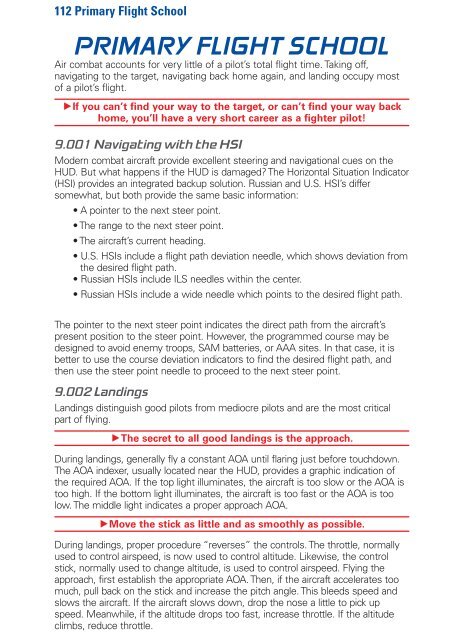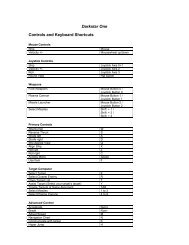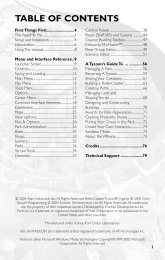Heads-Up Display Modes 35 - Metaboli
Heads-Up Display Modes 35 - Metaboli
Heads-Up Display Modes 35 - Metaboli
Create successful ePaper yourself
Turn your PDF publications into a flip-book with our unique Google optimized e-Paper software.
112 Primary Flight School<br />
PRIMARY FLIGHT SCHOOL<br />
Air combat accounts for very little of a pilot’s total flight time. Taking off,<br />
navigating to the target, navigating back home again, and landing occupy most<br />
of a pilot’s flight.<br />
hIf you can’t find your way to the target, or can’t find your way back<br />
home, you’ll have a very short career as a fighter pilot!<br />
9.001 Navigating with the HSI<br />
Modern combat aircraft provide excellent steering and navigational cues on the<br />
HUD. But what happens if the HUD is damaged? The Horizontal Situation Indicator<br />
(HSI) provides an integrated backup solution. Russian and U.S. HSI’s differ<br />
somewhat, but both provide the same basic information:<br />
• A pointer to the next steer point.<br />
• The range to the next steer point.<br />
• The aircraft’s current heading.<br />
• U.S. HSIs include a flight path deviation needle, which shows deviation from<br />
the desired flight path.<br />
• Russian HSIs include ILS needles within the center.<br />
• Russian HSIs include a wide needle which points to the desired flight path.<br />
The pointer to the next steer point indicates the direct path from the aircraft’s<br />
present position to the steer point. However, the programmed course may be<br />
designed to avoid enemy troops, SAM batteries, or AAA sites. In that case, it is<br />
better to use the course deviation indicators to find the desired flight path, and<br />
then use the steer point needle to proceed to the next steer point.<br />
9.002 Landings<br />
Landings distinguish good pilots from mediocre pilots and are the most critical<br />
part of flying.<br />
hThe secret to all good landings is the approach.<br />
During landings, generally fly a constant AOA until flaring just before touchdown.<br />
The AOA indexer, usually located near the HUD, provides a graphic indication of<br />
the required AOA. If the top light illuminates, the aircraft is too slow or the AOA is<br />
too high. If the bottom light illuminates, the aircraft is too fast or the AOA is too<br />
low. The middle light indicates a proper approach AOA.<br />
hMove the stick as little and as smoothly as possible.<br />
During landings, proper procedure “reverses” the controls. The throttle, normally<br />
used to control airspeed, is now used to control altitude. Likewise, the control<br />
stick, normally used to change altitude, is used to control airspeed. Flying the<br />
approach, first establish the appropriate AOA. Then, if the aircraft accelerates too<br />
much, pull back on the stick and increase the pitch angle. This bleeds speed and<br />
slows the aircraft. If the aircraft slows down, drop the nose a little to pick up<br />
speed. Meanwhile, if the altitude drops too fast, increase throttle. If the altitude<br />
climbs, reduce throttle.















